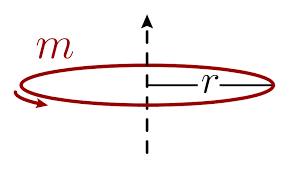Kickstart

I realized that I forgot to write about the calculation where I found the required minimum rotational velocity of the flywheel to provide the engine with a sufficient kickstart. I need to make sure that this velocity is low enough that I can reasonably give the flywheel a spin to get the engine started. In entry 8, I found the equation describing the relationship between rotational kinetic energy and rotational velocity:
$$\omega_{initial} = \sqrt{E_{initial} \over I}$$
There are two variables we need to calculate the rotational velocity of the kickstart — the required energy during the kickstart, and the flywheel’s moment of inertia. From the theoretical model of my engine, it seems that there needs to be enough initial energy so that 11.167 J of negative work can be done on the flywheel without it stopping completely. I’ll round this all the way up to 15 J to account for frictional losses and whatnot. Therefore, the flywheel should have an initial rotational kinetic energy of 15 J. Deriving the flywheel’s moment of inertia, on the other hand, requires calculations beyond the scope of this course that I don’t yet have the background to do. I’ll use an online calculator to find my flywheel’s moment of inertia: https://www.calctown.com/calculators/moment-of-inertia-of-ring
I’m assuming that my flywheel is a ring of evenly distributed mass. Since the flywheel’s mass is close to the edge of the flywheel already to maximize rotational inertia, this is a reasonable assumption. The mean radius of the flywheel mass is 1.625”, or 0.041275 m. I can calculate its weight based on its density and shape. The density of 1020 carbon steel, which the flywheel mass is made of, is 7.87 g/cm3. The flywheel is a hollow tube, with an outer radius of 1.75”, an inner radius of 1.5”, and a height of 1”. This gives it a volume of approximately 2.55 in3, or 41.829 cm3. Therefore, the flywheel’s weight is 329.19 g, or 0.329 kg. The moment of inertia about the flywheel’s perpendicular axis, according to the calculator, is 5.605x10-4 kg m2.
Considering this: $$\omega_{initial} = \sqrt{15 J \over 5.604×10^{-4}}$$
This gives me a rotational velocity of 146.4 rad/s! Yikes! That translates to approximately 23.29 revolutions per second! I don’t think my hand can move that fast, so this seems like a job for a drill. The average drill runs at about 1500 RPM, which translates to about 25 revolutions per second. Hopefully that’s enough of a margin to work with. In reality, the required rotational velocity might be a bit lower than 23.29 revolutions per second since the flywheel as a whole is heavier than just the mass ring, which may help a bit.
Footnote: If I’m going to be using a drill to kickstart the flywheel anyways, this initial velocity value doesn’t matter too much — instead, I can just use the drill to continue to supply the flywheel with extra energy, until the engine is producing enough power to keep itself running.
There are two variables we need to calculate the rotational velocity of the kickstart — the required energy during the kickstart, and the flywheel’s moment of inertia. From the theoretical model of my engine, it seems that there needs to be enough initial energy so that 11.167 J of negative work can be done on the flywheel without it stopping completely. I’ll round this all the way up to 15 J to account for frictional losses and whatnot. Therefore, the flywheel should have an initial rotational kinetic energy of 15 J. Deriving the flywheel’s moment of inertia, on the other hand, requires calculations beyond the scope of this course that I don’t yet have the background to do. I’ll use an online calculator to find my flywheel’s moment of inertia: https://www.calctown.com/calculators/moment-of-inertia-of-ring
I’m assuming that my flywheel is a ring of evenly distributed mass. Since the flywheel’s mass is close to the edge of the flywheel already to maximize rotational inertia, this is a reasonable assumption. The mean radius of the flywheel mass is 1.625”, or 0.041275 m. I can calculate its weight based on its density and shape. The density of 1020 carbon steel, which the flywheel mass is made of, is 7.87 g/cm3. The flywheel is a hollow tube, with an outer radius of 1.75”, an inner radius of 1.5”, and a height of 1”. This gives it a volume of approximately 2.55 in3, or 41.829 cm3. Therefore, the flywheel’s weight is 329.19 g, or 0.329 kg. The moment of inertia about the flywheel’s perpendicular axis, according to the calculator, is 5.605x10-4 kg m2.
Considering this: $$\omega_{initial} = \sqrt{15 J \over 5.604×10^{-4}}$$
This gives me a rotational velocity of 146.4 rad/s! Yikes! That translates to approximately 23.29 revolutions per second! I don’t think my hand can move that fast, so this seems like a job for a drill. The average drill runs at about 1500 RPM, which translates to about 25 revolutions per second. Hopefully that’s enough of a margin to work with. In reality, the required rotational velocity might be a bit lower than 23.29 revolutions per second since the flywheel as a whole is heavier than just the mass ring, which may help a bit.
Footnote: If I’m going to be using a drill to kickstart the flywheel anyways, this initial velocity value doesn’t matter too much — instead, I can just use the drill to continue to supply the flywheel with extra energy, until the engine is producing enough power to keep itself running.